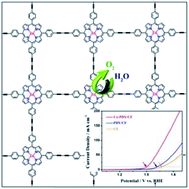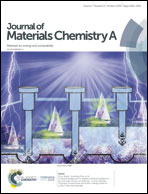Two-dimensional graphdiyne analogue Co-coordinated porphyrin covalent organic framework nanosheets as a stable electrocatalyst for the oxygen evolution reaction†
Abstract
As a rising-star 2D carbon material, graphdiyne (GDY), has received wide attention for its promising applications in many fields due to its unique butadiyne structure. However, owing to a lack of active sites, GDY just serves as a catalyst support in the electrocatalytic process, especially OER. Developing a new monomer with highly active centers for GDY is an effective strategy to overcome this unfavorable factor. Herein, a metalloporphyrin-based GDY analogue (Co-PDY) with a unique π-conjugated structure was innovatively designed and prepared through a Glaser–Hay coupling reaction on copper foam. Cobalt centers of metalloporphyrin moieties can provide numerous electrocatalytic sites for OER; also, the electrons can be transferred rapidly through the butadiyne linkages in the electrocatalytic process. The expanded pore structure (2.34 nm) of Co-PDY also serves as an effective transmission channel for small molecule diffusion to maintain the following catalytic process. These three factors altogether endow Co-PDY with excellent OER catalytic performance, including a small overpotential of 270 mV at 10 mA cm−2, a low Tafel slope of (99 mV dec−1), and promising long-term stability and durability. Meanwhile, the Co-PDY/CF electrode also displayed an acceptable electrocatalytic performance for HER in alkaline media. Profiting from the above characteristics, Co-PDY can be regarded as a promising electrocatalyst for new energy devices.



 Please wait while we load your content...
Please wait while we load your content...